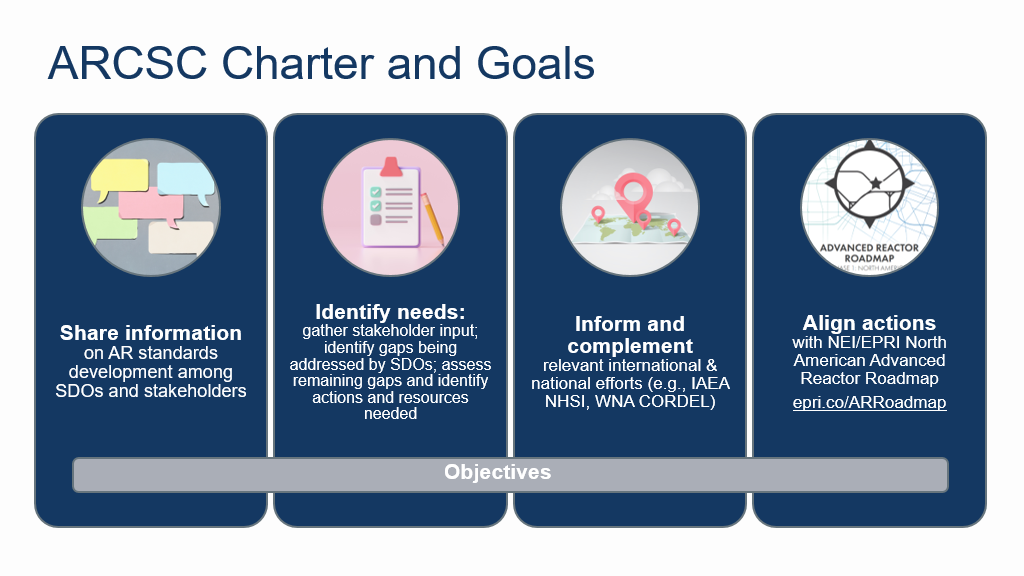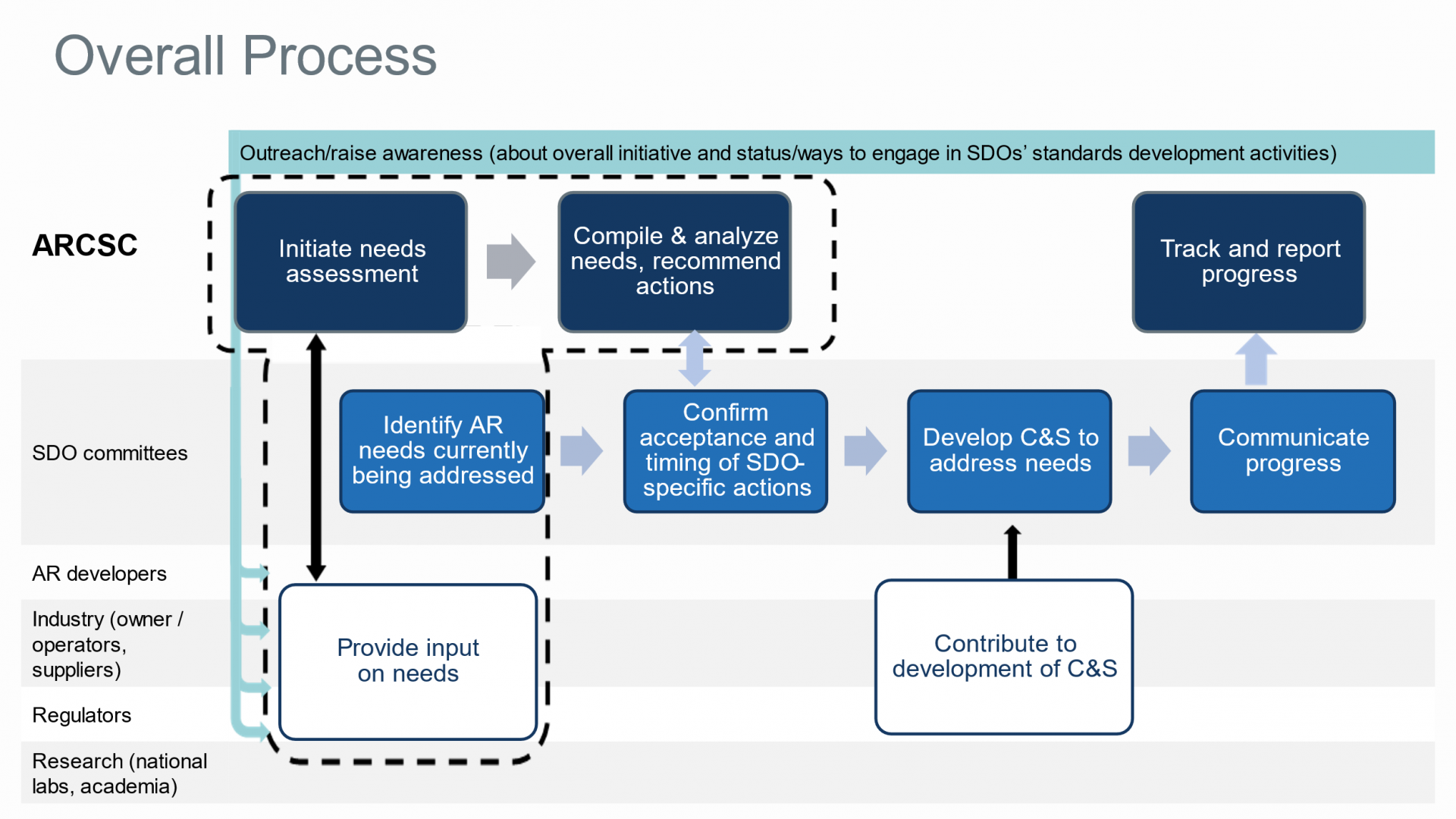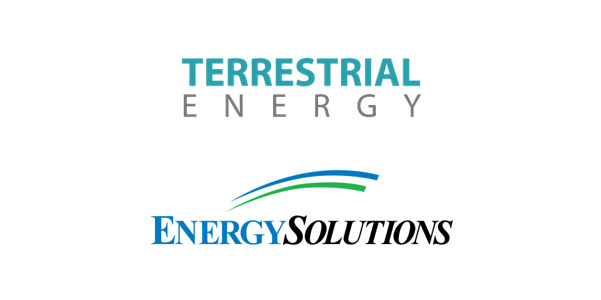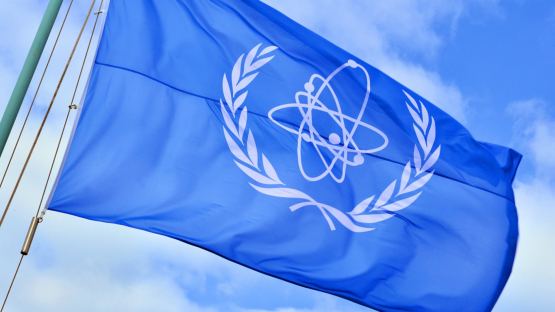ARCSC holds second workshop
The Advanced Reactor Codes and Standards Collaborative (ARCSC) held its second workshop on November 30, 2023, in Washington, D.C. The hybrid event had just over 200 participants, including representatives from standards development organizations (SDOs), the Electric Power Research Institute, the Nuclear Energy Institute, national laboratories, government agencies, vendors, advanced reactor designers, and consultants as well as representatives from other U.S. industry and international organizations, including the International Atomic Energy Agency. ANS Standards Board chair Andrew Sowder, senior technical executive at EPRI, welcomed attendees to EPRI’s offices, where the workshop was held.
ARCSC first came together in late 2022 to ensure the development, alignment, and timely availability of U.S., Canadian, and international codes and standards (C&S) needed to support large-scale advanced reactor deployment. The collaborative is facilitated by NEI and EPRI as part of the C&S actions identified in the NEI/EPRI North American Advanced Reactor Roadmap (the Roadmap). Kathryn Hyam, director of nuclear codes and standards at the American Society of Mechanical Engineers, and Larisa Logan, standards director with the CSA Group, jointly chair the ARCSC. The American Nuclear Society, the ASME, and the CSA Group are founding members of the ARCSC.
ARCSC’s connection to the Roadmap
The execution of the Roadmap is supported by the Roadmap Implementation Board (RIB), which includes representation from eight nongovernmental organizations; two government organizations; seven utilities; six original equipment manufacturers; and one engineering, procurement, and construction firm. The purpose of the ARCSC workshop was to address and discuss how the collaborative is working to meet its charter and goals.
Mark Richter, technical advisor at NEI, briefly reviewed the ARCSC charter and goals and provided attendees with some background on the Roadmap. C&S is included in the plan’s third pillar (“Technology Readiness”). The Roadmap recognizes the need for timely development of C&S as an essential component of advanced reactor strategy for large-scale deployment and to meet national energy, climate, economic, and security goals. The need to support SDOs and subject matter experts who volunteer their time to support standards programs is essential. Funding and in-kind support are both critical to ensure C&S are available within the requisite timelines. Stakeholder engagement, especially from advanced reactor designers, is vital. NEI and EPRI are facilitating the operation of the ARCSC to implement the C&S actions, in conjunction with the RIB and identified in the Roadmap action plans.
ARCSC has engaged advanced reactor designers and other sector representatives through a recent survey to identify and prioritize needed C&S, expanding on the work of NEI 19-03 (Rev.1), “Advanced Reactors Codes and Standards Needs Assessment.” The collaborative comprises U.S. and Canadian organizations to streamline the use of C&S in designs deployed in both countries. It also looks to facilitate harmonization of U.S. and international C&S to support the export of advanced reactor designs, offering potential participation with organizations in other countries partnering with the U.S. and Canada on advanced reactors.

International activities
Workshop attendees heard presentations from international participants like Pekka Pyy, with IAEA’s division of nuclear power; Seiji Asada, with Mitsubishi Heavy Industry and SDO Convergence Board chair; and Ronan Tanguy, licensing program lead at the World Nuclear Association.
Pyy presented on the IAEA’s Nuclear Harmonization and Standardization Initiative (NHSI) and common approaches on C&S. The NHSI brings together policymakers, regulators, designers, vendors, and operators to develop common regulatory and industrial approaches to facilitate the safe and secure deployment of small modular reactors and other advanced nuclear technologies to maximize their contribution to achieving the goals of Agenda 2030 and the Paris Agreement, including reaching net-zero carbon emissions by 2050.
Asada provided a brief background and reported on the SDO Convergence Board’s activities. The board started in 2013 and includes members from France, the United States, Canada, China, Japan, Korea, Russia, the Czech Republic, and the United Kingdom. It seeks to limit divergence on individual requirements and achieve harmonization on individual requirements, where realistic and practical for nuclear power plant C&S; and it collaborates with global stakeholders, leading to harmonization and minimization of code divergence.
Tanguy closed out the international presentations with an overview of C&S initiatives by WNA Cooperation in Reactor Design Evaluation and Licensing (CORDEL). CORDEL was established in 2007 to promote the standardization of nuclear reactor designs and harmonized approaches to licensing.
Of great interest to the community is the harmonization of terminology both nationally and internationally. A suggestion was made for the ARCSC to form a subcommittee on “principles of harmonization” to see whether the ARCSC can help to achieve consensus on basic principles. The ARCSC will need to determine whether this activity falls within its current scope and resources.
ARCSC standards development road map process
Kate Hyam reviewed the collaborative’s activities since the December 1, 2022, kickoff meeting. Since that time, a charter and process document have been developed, a list of nuclear-related standards was collected, and a survey was issued in September 2023 to collect industry feedback on advanced reactor standards needs. The survey has received over 100 responses and will remain open for any further responses. Hyam shared the names and positions of the ARCSC team. Representatives include ANS, ASME, the CSA Group, EPRI, NEI, the Institute of Electronic and Electrical Engineers, the American Society of Civil Engineers, and the American Institute of Steel Construction. The team also includes observers from the Department of Energy, the International Society of Automation, the Institute of Nuclear Power Operations, and the Nuclear Regulatory Commission.
Using the diagram pictured here, Hyam then walked everyone through the overall process the ARCSC will use to identify advanced reactor C&S needs, where they currently are in the process, and what conclusions will be drawn. The dashed black line represents the needs assessment process (second objective) which is the current activity of the collaborative.

SDO processes must be respected, so two-way communication between ARCSC and SDO committees will be critical to validate the input received from stakeholders regarding gaps and needs. Each SDO will be asked to evaluate and then determine whether to accept any actions to address gaps. Each SDO will also continue to develop and approve their own content but will be requested to provide feedback to the ARCSC on their progress. Hyam stressed that ARCSC needs participation and coordination from all stakeholders, especially advanced reactor designers, to achieve the objectives.
Pat Schroeder, ANS standards manager, explained the process for creating a list of nuclear-related standards and projects. The ARCSC team felt that the community would benefit from knowing what standards are currently available to leverage existing work. Eighteen SDOs were asked to provide a list of their standards and projects. Two SDOs did not have any applicable standards, and two SDOs did not respond. The remaining 14 SDOs contributed to the list of approximately 1,000 standards and projects. Information collected includes the designation, title, and status of each standard or project. Also requested was whether the SDO believes its standards are applicable to advanced reactors and to categorize the use of the standard into one of the six topical areas included in the recent industry survey. Some SDOs had only a handful of nuclear-related standards, while others had hundreds. The list reflects the many disciplines needed to design and operate nuclear power plants.
Preliminary statues from the ARCSC needs assessment survey
Larisa Logan reviewed the structure of the industry survey, which was arranged around six topical areas and questioned what standards are being used and whether these standards have any gaps. The survey was launched September 14, 2023, and an announcement was made at the September NRC Standards Forum. It was further distributed through ARCSC members. As of November 1, 2023, the survey had received 103 responses. The responses reflect a good representation of the industry and reactor type. The majority of standards currently being applied fall into the design and construction topical area; however, 25 comments about the lack of standards in design and construction were noted. Although the requested response date of November 1 has passed, the survey link remains live, and there is an ongoing invitation for stakeholders to provide further input, which will be monitored periodically.
Donald Eggett, immediate past chair of the ANS Standards Board, provided a high-level summary of the preliminary evaluation of ARSCS survey responses on ANS standards. ANS grouped its responses by standard to get a better understanding of the industry’s use and need. The majority of ANS standards in use by advanced reactor designers are in the design and construction area. Twelve of ANS’s standards were recognized in use by more than five responders. Feedback on whether these standards had gaps were mixed. ANS will likely need to contact responders for more information. As a start, ANS will explore the following comments:
- A revision of ANSI/ANS-2.26-2004 (R2021), Categorization of Nuclear Facility Structures, Systems, and Components for Seismic Design, to be consistent with the License Modernization Project (NEI 18-04), Seismic Design Criteria for Structures, Systems, and Components in Nuclear Facilities (ASCE 43), and both NRC and DOE requirements.
- A revision of ANSI/ANS-6.4-2006 (R2021), Nuclear Analysis and Design of Concrete Radiation Shielding for Nuclear Power, to interface (harmonize) with ASCE standards.
- A revision of ANSI/ANS-15.8-1995 (R2023), The Quality Assurance Program Requirements for Research Reactors, to be applicable to advanced reactors.
- A resurrection of withdrawn standard ANS-54.8-1988 (W2000), Liquid Metal Fire Protection in LMR Plants.
- A revision of ANSI/ANS-58.14-2011 (R2022), Safety and Pressure Integrity Classification Criteria for Light Water Reactors, to incorporate risk-informed and/or performance-based methods.
- A revision of ASME/ANS RA-S-1.4-2021, Probabilistic Risk Assessment Standard for Advanced Non–Light Water Reactor Nuclear Power Plants, to include releases resulting from purposeful human-induced security threats and address NRC staff positions in RG 1.247 (for trial use), Acceptability of Probabilistic Risk assessment Results for Non-Light-Water Reactor Risk-Informed Activities.
Eggett closed by explaining the process ANS will use to evaluate the survey comments. It will be led by and include a review by its Priority Task Group, which Eggett will chair. The evaluation will also incorporate engagement from ANS’s consensus committees, subcommittees, and their working groups using similar ranking criteria used in NEI 19-03 (Rev. 1) to establish priority. This process will be shared with ARCSC to gain their “buy-in” for consistency when evaluating the comments received.
Advanced reactor industry insight
ARCSC welcomed five advanced reactor designers to provide additional insight into their survey responses. Presentations were provided by Dennis Henneke, consulting engineer with GE-Hitachi Nuclear Energy; Steven Unikewicz, Natrium design authority with TerraPower; Jon Facemire, licensing manager with X-energy; William Smith, senior vice president of operations and engineering at Terrestrial Energy; and Jodine Jensen Vehec, probabilistic safety analysis engineer–SMR at Holtec International. A summary of key points from advanced reactor designer presentations include the following:
- Ensure C&S provides cost-effective, risk-informed/performance-based options (e.g., the lower the plant risk, the lower the cost to meet code requirements).
- Continue support for the IAEA and WNA standards harmonization activities but try to minimize overlap and burden on advanced reactor designers.
- ANS should update and reissue ANS-54.8-1988 (W2000), Liquid Metal Fire Protection in LMR Plants.
- A standard like ANSI/ANS-5.1-2014 (R2019), Decay Heat Power in Light Water Reactors, but for non–light water plants, such as sodium-cooled fast reactors, is desirable to minimize effort and regulatory risk.
- The ANS/ASME Joint Committee on Nuclear Risk Management (JCNRM) needs to issue ASME/ANS RA-S-1.5, Advanced Light Water Reactor PRA Standard (proposed new trial-use standard) and ASME/ANS RA-S-1.6, Standard for Low Power and Shutdown Methodology for PRA Applications (revision and redesignation of trial-use standard ANS/ASME-58.22-2014). A follow-up activity for the JCNRM is to revise ASME/ANS RA-S-1.4-2021, Probabilistic Risk Assessment Standard for Advanced Non-LWR Nuclear Power Plants, to include near-term updates to other JCNRM standards.
- C&S should allow gradation in quality assurance requirements for different functions of the same component.
- Industry alignment on key philosophies for mapping of licensing basis event categories to code service levels/stress analysis could ease regulatory approval.
- C&S language could benefit from an update to License Modernization Project terminology.
- High-quality data sufficient to meet code requirements is needed for graphite.
Takeaways from discussions were that it is critical to balance requirements and benefits/impact for the current fleet and advanced reactors. There is a need to align terminology and have clear definitions and understandings across standards. Support in this area from ARCSC should be a priority, although it was recognized that it is not feasible to have common single terminology. Instead, understanding the meaning in context should be the goal. Challenging technical areas of concern include structural costs (concrete and steel), qualification data for graphite, overdesigning to meet requirements that vary by country, and standardization for varying reactor types. Prioritization of standards needs, staffing, and resources also will need to be addressed.
ARCSC future actions
The industry survey will continue to be evaluated to identify specific actions, gaps, and comments. The process to extract SDO-specific responses to analyze cross-cutting themes will be defined by ARCSC over the coming months. The collaborative will share responses with the responsible SDOs during spring 2024. A two-way dialogue will be established with each SDO to provide responses back to ARCSC by this summer. Subsequent steps include compiling overall resource needs and seeking prioritization input from the RIB during fall 2024.The next ARCSC workshop is tentatively scheduled to be held in September 2024 to provide a progress update and review the next set of actions moving forward. An ARCSC website is also being created and should be available soon to provide public access to survey response information, reference files, contact information, and events with meeting presentations.
Individuals with questions or those interested in more information about ARCSC may contact standards@ans.org.








